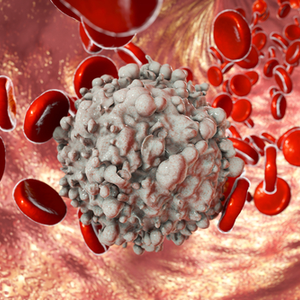
What is leukaemia?
Leukaemia, or so-called blood cancer, is a generic term for various diseases of the blood cells and is a rather rare cancer compared to breast cancer, bowel cancer or lung cancer. In leukaemia, the blood cells in the bone marrow change and multiply uncontrollably, displacing healthy blood cells. The different forms of leukaemia are distinguished according to the course of the disease and the number of blood cells affected. As a rule, leukaemia affects adults. However, children can also develop the disease.
How does leukaemia develop?
Blood is formed in the bone marrow. Due to an error in the genetic information, it can happen that a blood cell does not mature properly and is unable to function. This results in so-called blasts, which can also displace healthy blood cells through uncontrolled growth. Doctors distinguish between lymphatic and myeloid leukaemia:
- Lymphatic leukaemias: White blood cells (lymphocytes) degenerate during the development phase.
- Myeloid leukaemias: Myeloid cells are malformed. These include red blood cells, platelets and, in addition to lymphocytes, many types of white blood cells.
Further distinctions between types of leukaemia
Leukaemia can have an acute or a chronic course. While acute leukaemia occurs very suddenly and causes severe symptoms, chronic leukaemia tends to progress more gradually and goes unnoticed at first:
- Acute lymphoblastic leukaemia (ALL): is rather rare and often affects children under the age of five. It occurs without warning and usually progresses quickly.
- Acute myeloid leukaemia (AML): is the most common type of acute leukaemia, affecting mainly older people.
- Chronic myeloid leukaemia (CML): usually occurs in adults and is due to a genetic mutation.
- Chronic lymphocytic leukaemia (CLL): is a special case and is classified as a lymphoma, i.e. cancer of the lymph glands.
Symptoms of leukaemia
The symptoms of acute leukaemia appear quite unexpectedly and are expressed in initially unspecific signs that can also indicate other diseases:
- severe tiredness, fatigue and paleness as an expression of the reduced number of red blood cells
- Susceptibility to infections and/or fever as a result of the reduced number of white blood cells
- Bleeding from the nose or gums, formation of bruises (haematomas) after minor injuries due to the reduced number of blood platelets
- Bone and/or joint pain as a result of the spread of leukaemia cells in the bone marrow
- Abdominal pain or unusual feeling of pressure as a result of the enlargement of the spleen or liver
- Dizziness, headache or paralysis caused by the impairment of the central nervous system
If it is chronic myeloid leukaemia, the symptoms do not appear until late in the course of the disease. The first signs might include the following non-specific complaints:
- Swelling of the lymph nodes
- Abdominal pain caused by an enlargement of the spleen
As the disease progresses, the symptoms of acute and chronic leukaemia become similar.
How is leukaemia diagnosed?
To diagnose leukaemia, the general practitioner will first order a complete blood count. If the blood count is abnormal, an internal medicine specialist, for example, will ask for further laboratory results that provide information about the function of the liver or kidneys. In a further step, the doctor can also order a bone marrow examination to obtain valuable information about the composition of the blood-forming cells.
How is leukaemia treated?
The treatment of a leukaemia disease is always individually adapted to the patient. In addition to the type of leukaemia, the course of the disease, the age of the patient and the general state of health also play an important role. Chemotherapy is the most important type of treatment for acute leukaemia, while chronic myeloid leukaemia is usually treated with special drugs called tyrosine kinase inhibitors. In some patients, however, stem cell therapy is also carried out, in which the bone marrow is deliberately destroyed in order to replace it with healthy stem cells.
Become a member now
As a member, you will receive further information and frequencies on this topic! Log in here!
